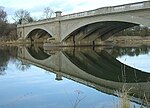RAF Newton
1939 establishments in England2000 disestablishments in EnglandEngvarB from November 2015Royal Air Force stations in Nottinghamshire

Royal Air Force station Newton or more simply RAF Newton (ICAO: EGXN) is a former Royal Air Force station located 7 miles (11 km) east of Nottingham, Nottinghamshire and 10.7 miles (17.2 km) south west of Newark-on-Trent, Nottinghamshire, England. It was used briefly as a bomber base for squadrons to re-equip after the Battle of France and then as a flying training school during the Second World War and beyond until 2000.
Excerpt from the Wikipedia article RAF Newton (License: CC BY-SA 3.0, Authors, Images).RAF Newton
Shelford Road, Rushcliffe
Geographical coordinates (GPS) Address Nearby Places Show on map
Geographical coordinates (GPS)
| Latitude | Longitude |
|---|---|
| N 52.966388888889 ° | E -0.98944444444444 ° |
Address
Shelford Road
Shelford Road
NG13 8HT Rushcliffe
England, United Kingdom
Open on Google Maps







